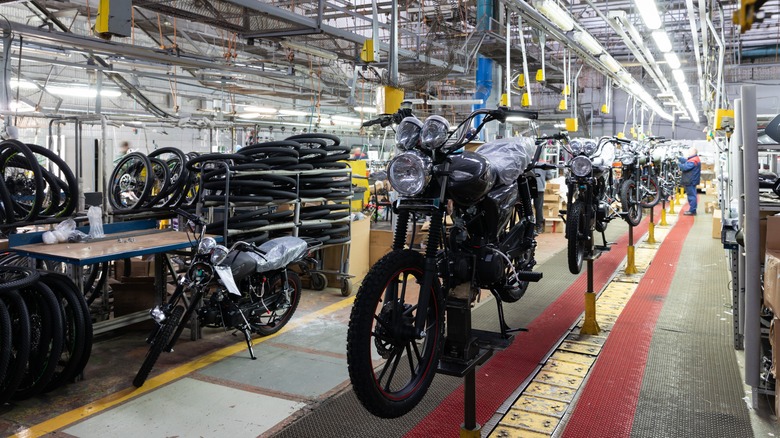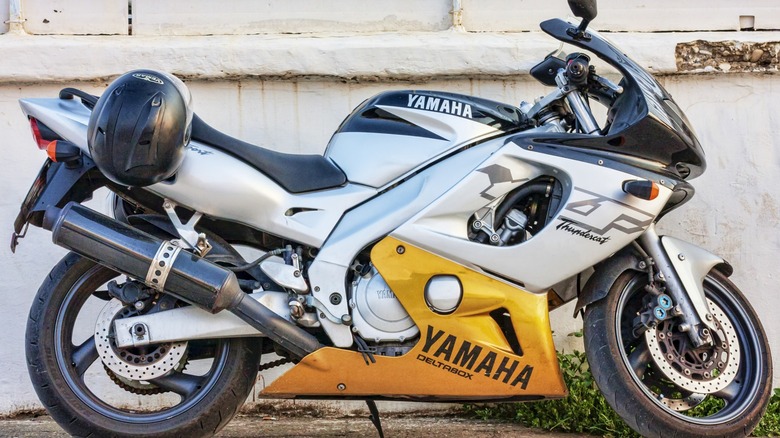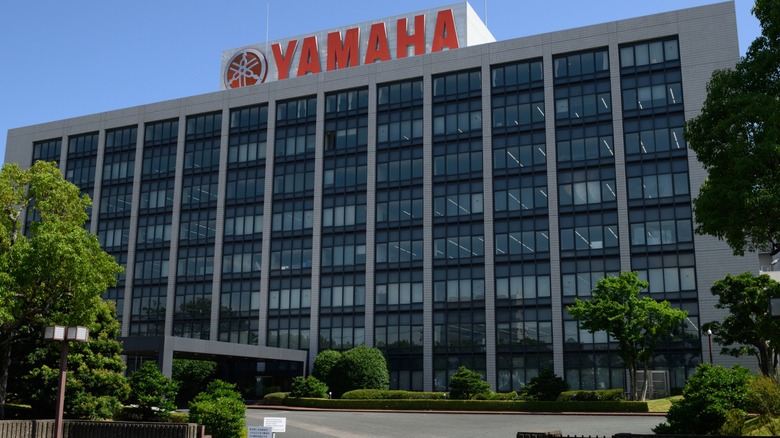Where Are Yamaha Motorcycles Made, And Who Owns The Company Now?
Though it may come as a surprise, Yamaha didn't start out making motorcycles. One clue to the company's origin hides in plain sight in its logo, which features three interlocking tuning forks. Before there was the Yamaha Motor Company, there existed in postwar Japan its predecessor, Nippon Gakki Co. Ltd., which was strictly a piano manufacturer. The connection between pianos and motorcycles lies in the fact that within the former is a strong but flexible steel-frame skeleton, that Nippon Gakki had perfected the production of using a unique vacuum and sand-casting process.
While building a strong frame for the motorcycle was no big leap in adapting the process for the prototype, the YA-1, produced in 1954, the same can't be said of the cylinder head cover. Initial attempts at creating the prototype's 125cc cylinder's external cooling fins left Nippon Gakki engineers scratching their heads, but further refinements to the vacuum casting process eventually achieved the desired result.
Yamaha Motors spun off the following year and today produces a complete line of street bikes, off-road motorcycles, UTVs, ATVs, and snowmobiles under its Motor Sports banner, not to mention electric bicycles, boats, outboard motors, personal watercraft, generators, golf carts, and mobility systems. Three decades later, in 1987, Nippon Gakki changed its name to Yamaha Corporation, creating two separate Yamaha companies; and not giving up on a good and going thing, Yamaha still sells pianos and other musical equipment.
Where are Yamaha motorcycles made?
As of April 2022, the Yamaha Motor Company had manufacturing operations in several Asian countries and a small presence in North and South America. Its facilities in Japan produce the highest percentage of its products, but China, Taiwan, Indonesia, Thailand, Vietnam, India, Brazil, and the U.S. contribute to the total production as well.
Yamaha builds most of its higher-end motorcycles in Japan, including the YZF-R1, YZF-R6, and MT-10. However, bikes like the XMAX400, Tenere 700, and retro-styled XSR700 come out of assembly plants, like those in France and Spain, for example. Some beginner-friendly motorcycles, such as the YZF-R3 and MT-03, originate in Indonesia and Brazil, and smaller bikes like the YZF-R125 and MT-125 are made primarily in India.
Most of the casting of parts appears to be made in East Asia, primarily in Japan's Morimachi, Hamakita, and Iwata plants, and assembly lines are set up closer to the points of sale around the world. One such plant in Newnan, Georgia cranks out, not motorcycles but Yamaha's various outdoor, gas-powered toys.
If you're curious about the country of origin of a specific motorcycle, the vehicle identification code, or VIN, could provide some clues. While the VIN provides a lot of information, it always starts with a three-letter world manufacturer identifier or WMI, and the 11th position identifies the vehicle's assembly location. The easiest way to make sense of it is with a free online VIN decoder.
Who owns Yamaha Motor Company?
The Yamaha Motor Company is a publicly traded entity registered on the Tokyo Stock Exchange. The company has roughly 350 million shares outstanding as of mid-2023. The three largest shareholder groups include eighty-one financial institutions, with 34.6 percent, 1,003 foreign investors, with 31.5 percent, and 89,046 "individual investors and others," with 14.6 percent of the outstanding shares, which includes Yamaha Motor Company's treasury shares.
Other than the Yamaha Motor Company itself, with 4.4 percent treasury shareholdings, the four largest individual shareholders combine to hold over one-third of the outstanding shares. The largest of those is The Master Trust Bank of Japan, Ltd., with 18.59 percent. Next is the Custody Bank of Japan, Ltd., with 6.73 percent. Yamaha Corporation is the largest shareholder that's not a financial institution, with 4.67 percent. Financial services provider SMBC Nikko Securities Inc. rounds out the top four with 3.75 percent.


